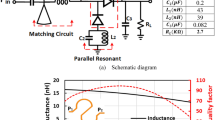Abstract
At relatively high frequencies, the application of an alternating current through the body or a body segment results in electromagnetic stray fields which reduce the amount of current actually injected into the tissue under study. This radiation effect can be reduced by use of a symmetrical configuration current source. The symmetry of such an arrangement, however, depends on the stray capacitances of the source with respect to surrouding equipment. To minimise these effects, it is required that the source is electrically isolated from the surrounding equipment and the subject under study. In this manner stray capacitances with respect to elements of the current source are reduced. In such a configuration common mode voltages to the input amplifier of the measuring system are also reduced. The paper describes design considerations and the implementation of a wideband current source capable of injecting alternating current in the order of 300μARMS into biological tissue having impedances up to 1kΩ. Current stabilisation is obtained by means of a control circuit which measures the actual current passing through the tissue under study. Leakage currents arising from shielding and stray capacitances are compensated for. The usable frequency range is between 4 kHz and 1024 kHz and current stability is better than 0.2%. Through the use of a symmetrical, floating circuit a configuration is obtained which substantially reduces stray effects. The current source is connected to other circuits by means of two isolation ports: (1) a transformer coupling for the carrier frequency; and (2) an opto-coupler to transfer a phase reference signal obtained from current measurement. The current amplitude can be modulated by controlling the reference input to the control loop by means of a third auxiliary isolation port for transfer of the modulating signal.
Similar content being viewed by others
References
Blad, B., Lindström, K., Bertenstam, L. andPersson, B. R. R. (1994): ‘A current-injecting device for electrical impedance tomography,’Clin. Phys. Physiol. Meas.,15, (supplement 2A), A69-A77
Bragós, R., Rosell, J. andRiu, P. J. (1994): ‘A wide-band Ac-coupled current for electrical impedance tomography,’Clin. Phys. Physiol. Means.,15, (supplement 2A), A91-A99
Brown, B. H. andBarber, D. C. (1982): ‘Applied potential tomography-a newin vivo medical imaging technique.’ Proc. of Hospital Physicists’ Association, Annual Conf., Sheffield
Brown, B. H., Barber, D. C., Wei Wang, Liqin Lu, Leathard, A. D., Smallwood, R. H., Hampshire, A. R., Mackay, R. andHatzigalanis, K. (1994): ‘Multi-frequency imaging and modelling of respiratory related electrical impedance changes,’Physiol. Meas.,15, A1–12
Ezenwa, B. N., Couch, W., Wu, C. andJosé, A. (1993): ‘Multiple frequency system for body composition measurement,’Proc. Int. Conf. IEEE EMBS,15, 1020–1021
Goovaerts, H. G., de Vries, F. R., Meijer, J. H., de Vries, P. M. J. M., Donker, A. J. M. andSchneider, H. (1988): ‘Microprocessor-based system for measurement of electrical impedances during hemodialysis and in postoperative care,’Med. Biol. Eng. Comput.,26, 75–80.
Goovaerts, H. G., Faes, Th. J. C., Raaijmakers, E. andHeethar, R. M. (1998): ‘A wideband high common mode rejection ratio amplifier and phase-locked loop demodulator for multifrequency impedance measurement,’Med. Biol. Eng. Comput.,36, pp. 000-000
Heethaar, R. M. andGoovaerts, H. G. (1996): ‘Apparatus for invivo non-invasive measurement of a biological parameter concerning a bodily fluid of a person or animal.’ International Patent Application PCT/NL96/00374
International Standard IEC601-1 (1988): Medical electrical equipment, Part 1: General Requirement for safety. Bureau Central de la Commision Electrotechnique Internationale, Genève, pp. 89–99.
Kubicek, W. G., Karnegis, J. N., Patterson, R. P., Witsoe, D. A. andMattson, R. H. (1966): ‘Development and evaluation of an impedance cardiac output system,’Aerospace Med.,37, pp. 1208–1212
Lazano, A., Rosell, J. andPallás-Areny, R. (1990): ‘Two-frequency impedance plethysmograph: real and imaginary parts,’Med. Biol. Eng. Comput.,28, 38–42
Raaijmakers, E., Faes, Th. J. C., Goovaerts, H. G., de Vries, P. M. J. M. andHeethaar, R. M. (1997): ‘The inaccuracy of Kubicek’s one-cylinder model in thoracic impedance cardiography,’IEEE Trans. Biomed. Eng.,44, pp. 70–76.
Author information
Authors and Affiliations
Rights and permissions
About this article
Cite this article
Goovaerts, H.G., Faes, T.J.C., Raajimakers, E. et al. An electrically isolated balanced wideband current source: basic considerations and design. Med. Biol. Eng. Comput. 36, 598–603 (1998). https://doi.org/10.1007/BF02524430
Received:
Accepted:
Issue Date:
DOI: https://doi.org/10.1007/BF02524430




